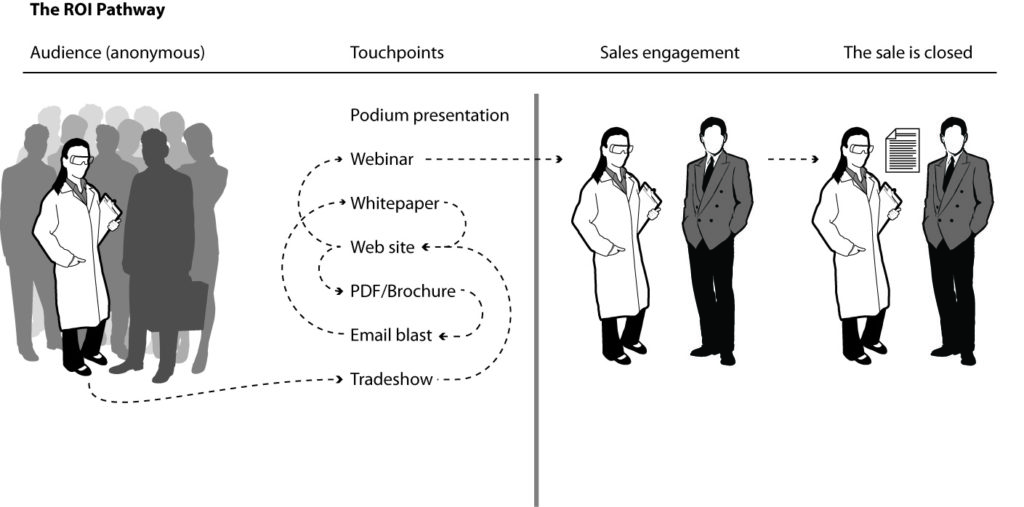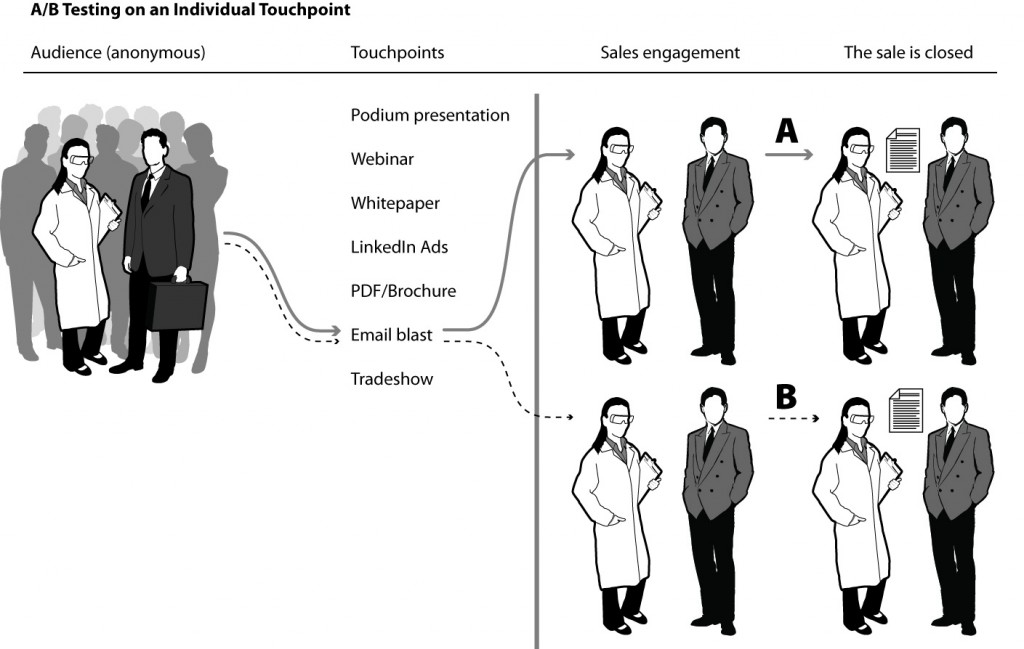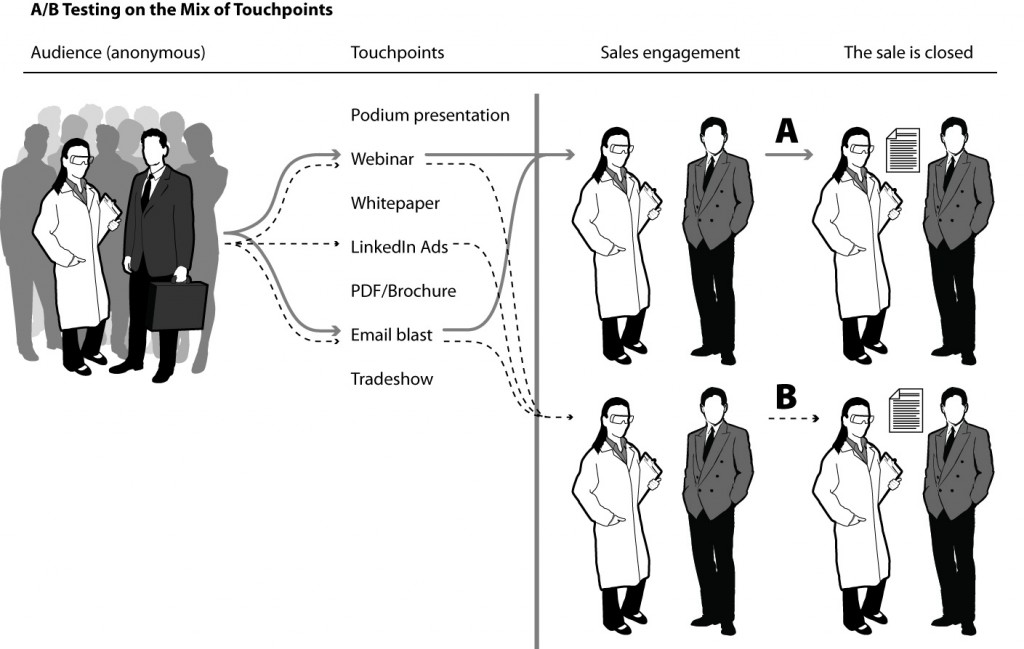Measuring Return on Investment (ROI) in Life Science Marketing (Part 3)
By David Chapin

SUMMARY
VOLUME 4
, NUMER 6
Focusing your expectations of marketing and tracking the proper marketing metrics lays the groundwork for improving your ROI performance over time. Part three of a three-part series.
The Marketing ROI pathway for life science organizations
As we discussed in the last two whitepapers, measuring ROI begins by outlining the steps that a prospect takes as they move closer to your life science organization. They emerge from the shadows of anonymity into the light of visibility. These steps are shown in a general way in Figure 1, with an anonymous audience on the left, and a closed sale on the right.

Figure 1: The ROI pathway. There are many steps on the ROI pathway, leading from an “anonymous” audience on the left, to communicating with them through your organization’s touchpoints, to sales engagement and ultimately to the close of a sale. Note that just one possible set of touchpoints on a particular pathway is shown here.
Through contact with your organization’s touchpoints, such as tradeshows, email marketing, brochures, your web site, etc., , the audience becomes aware of your life science organization and your organization may become aware of specific information about individual audience members.
With big-ticket sales that are mediated by a sales person (as opposed to smaller transactional sales) it is assumed that, at some point, a sales person will become involved, answering questions and guiding the buyer through the buying process. With an effective salesperson and a willing buyer, the sale will ultimately close.
Life Science Marketing ROI – difficult to determine
There are five systemic challenges to determining marketing ROI in the life sciences, as we reviewed in our last two issues: visibility, attribution, lack of control, multiple buyer types, and methodology.
The good news is that significant and useful measurements can be made, despite these systemic challenges. Here are three steps you can use to determine marketing ROI in the life sciences:
Step one for determining marketing ROI in the life sciences: Revise your expectations.
To be effective (and to avoid driving yourself completely crazy) you must revise what you can expect from your efforts to measure ROI. You must accept the systemic limitations (visibility, attribution, lack of control, multiple buyer types, and methodology) and accept that they make it impossible to obtain a clear and unambiguous ROI figure on global basis. (Global meaning the ability to measure your total marketing budget and quantify a total return on sales.)
There is another reason to revise your expectations, however, which is the fundamental difference between the ability and process of measuring sales and marketing.
Sales activity is notoriously difficult to quantify but sales results are very easy to measure. In contrast, marketing activity is easy to measure but the results are often synergistic or delayed and so are difficult to quantify.
For sales, a “global” ROI ratio is easy to calculate: we spend $X on the sales department and we get $Y in return. For marketing, the difficulty in measuring the impact of different activities and the combination thereof means that it does not lend itself to “global” measurement.
To generate the most meaningful and actionable data for marketing efforts, you need to focus less on measuring global ROI and more on measuring relative (or limited, local) ROI.
Local ROI does not try to draw an uninterrupted straight line between a given investment and a closed sale, but measures more limited results, such as the increase in leads, conversions, subscriptions, or webinar attendees. Using these types of measurements we can gain meaningful insight into the causes and effects of life science marketing and determine ROI on a more “local” level.
For example, you can calculate the ROI for a series of webinars, by calculating the resources required to put on the webinars, and measuring the results, such as the increase in the number of leads, the number of subscriptions to your thought leadership, or even (if you charge for your webinars) the financial return.
This is not to say we should ignore global figures. W. Edwards Deming, famous for his application of quality control methods in industry said, “The most important figures that one needs for management are unknown or unknowable, but successful management must nevertheless take account of them.” Some of the pertinent figures – such as total (global) ROI – are unknown or unknowable.
Despite this, we can make significant measurements that will give us insight into the causes and effects of life science marketing. So, it’s best to focus efforts on what can be measured, and how those measurements can be used in productive ways.
Step two for determining marketing ROI in the life sciences: Focus your measurements.
If global ROI is impossible to determine, let’s break down the global challenge into smaller ones. What can be measured? We can use Figure 1 as a guide.
Looking at the left-hand column, we can measure what our anonymous audience knows/thinks/feels about our brand, by measuring total brand perception or other global attributes of the brand. These measurements often involve querying large number of prospects and ranking competitive brands against each other.
In the touchpoints column, we can measure total number of leads generated for any effort. For example, how many people clicked on an email blast to read the details of the resulting offer. These measurements can be compared to historical data (other email campaigns); comparing them against competitors is difficult.
• Total brand perception
• Number of leads
• Conversion rates
• Quality of leads
• Sales opportunities generated
• Total sales
• Retention
Similarly, we can also measure the conversion rate at which people take a step closer to your organization. For example, how many people who read the email signed up for the webinar? How many actually attended the webinar? How many signed up for your thought leadership (content marketing) after the webinar? Again, these data will be compared against historical trends.
We can also track the quality of the audience that responds to your efforts. Putting on a webinar is great, and it’s even better if the webinar is crowded, but if the goal is to drive conversions of decision makers, and the attendees have no decision-making or decision-influencing power (which you could determine from the questions you ask as people sign up for your webinar), then your activity is worthless.
In the third column, we can track the opportunities that result from individual campaigns. There can be several steps from lead-generation (or conversion) to the creation of an opportunity, so we begin to run into the attribution challenge.
We can also track our total sales (the fourth column) though drawing a straight line back to marketing investment is generally impossible.
We can track retention (e.g., repeat sales) and relationships (e.g., net promoter score) metrics.
And we can track the investments (time, money, personnel) required for each of the touchpoints.
With these possible measurements in mind, we can begin to gather data, look for trends, establish benchmarks and optimize the marketing mix. At this point, it is common to be overwhelmed with the amount of data that might be collected, and the effort required to collect it. Our advice: start small. Pick a few measurements for a single touchpoint, or just a few measurements for a few touchpoints and begin there. Don’t try to measure everything at once, lest you succumb to the “paralysis of analysis.”
Step three for determining marketing ROI in the life sciences: be consistent.
As you set up your metrics, remember the following points:
Be consistent. Standardize your data gathering, so you can compare the results with confidence. For example, if you track your metrics for every program and every territory, then you’ll be able to compare their performance in a meaningful way.
Track the right metrics. Increasing the number of Facebook likes won’t necessarily help a biotech company or a contract manufacturing organization reach profitability any faster; make sure you are tracking metrics that affect your organizations long-term goals. You should be tracking both global metrics (e.g., total sales revenue) as well as local metrics (e.g., total web site visits, time on site, bounce rate, etc).
Create a dashboard. Standardizing (and sharing) your results will focus your efforts on those areas that drive results. As W. Edwards Deming said, “You can expect what you inspect.”
Step four for determining marketing ROI in the life sciences: focus on improving.
With metrics in hand, you’ll be able to start asking the interesting questions, such as: what is our cost per lead, or which activity gets us more leads? If you are like most people, you’ll be going through a three-stage process: watching the metrics, trying to improve them, and finally, you’ll be questioning what they really tell you. This will start an iterative feedback process during which you may modify what you measure and/or how you measure it, all the while simultaneously trying to improve your performance on your chosen metrics.
Split testing for improving marketing performance in the life sciences.
As you enter the second stage mentioned above, (trying to improve your performance on specific metrics), you’ll be faced with the challenge of determining what is working and what is not, that is, separating cause and effect. The scientific method can help you here, so consider the use of split testing, essentially an experiment in which two touchpoints are compared against each other. This comparison can be between completely different touchpoints (comparing a webinar against a whitepaper) or between slightly different variants of a single touchpoint.
In either case, when you limit the variability in your experiment to a few variables (or even to a single one), you can gain insight into which one has the most impact on the overall effort. This is sometimes known as A/B testing, a simplified case of multivariate testing.
Split (or A/B) testing is simple to execute and is similar in theory and practice to placebo-controlled clinical studies. In marketing we are not concerned about the possible effect of the placebo itself, so rather than testing against a non-active placebo, it is common to test one version of an outreach effort against another active version, isolating individual factors to determine which has the largest positive effect on the overall results.
Split testing is easiest and fastest with digitally-based outreach efforts, such as email, banner ads (Coronavirus business signage is taking onto a riduculous level), landing pages, etc, though it has been used for years in direct mail (and to a lesser extent in advertising). In an email-based example, the sender varies one portion of the email (say, the subject line), sending one version (let’s call this version A) to one randomly selected group of recipients and another version (B) to another randomly selected group (see figure 2). Comparing the results can give you significant insight into the effect of this marketing effort. At Forma, we use A/B testing to determine the best day to send out email blasts, the proper incentive amount to drive participation in market research, and the optimum design of landing pages, among many other questions.

Figure 2: A/B testing can provide insight on the proper development, design and implementation of a single touchpoint. In the example shown here, the upper group (A) receives a targeted email blast, while the lower group (B) receives a targeted campaign with a slightly modified email. Comparison of important outcomes between the two can provide information useful in optimizing individual aspects of a particular touchpoint, for example, the subject line or the call to action of the email.
Besides optimizing the performance of any one individual touchpoint, such as an email blast, there are other ways you might utilize split testing. One in particular is determining which combination of touchpoints is most effective. For example, one group of prospects might be the target of one particular array of marketing efforts: an email blast and a webinar. Another group will receive one additional touchpoint, such as a targeted LinkedIn ad. Comparing the two arms of the study will provide insight into the efficacy of the different combinations.

Figure 3: A/B testing can provide insight on the proper mix of touchpoints. In the example shown here, the upper group (A) receives a targeted campaign consisting of a webinar and an email blast, while the lower group (B) receives a targeted campaign with an additional touchpoint, in this case a series of LinkeIn ads.
The three keys to proper split testing in marketing for the life sciences.
There are three important things to remember when performing split testing:
GIGO – Garbage in, garbage out. As in all scientific experiments, asking the right questions (in the right way) is crucial for reliable, meaningful results. As I mentioned before, tracking Facebook likes may not be pertinent for a biotechnology company, but tracking retweets among a targeted group of discovery scientists may provide interesting information about the influence of a lead researcher. Make sure you measure and track the right data.
The test must include sufficient volume for the testing to be statistically significant. Comparing the response rates when only small numbers are involved is risky, because the variation in your response rates might be due to routine and uncontrollable variations in your sample population. In other words, beware of basing your decisions on a “one rat study.”
The larger the variation between the two arms of the study, the larger the uncertainty about the contribution of each individual component. When only a single variable is modified, great clarity can result. For example, modifying only the subject line of an email can help optimize that subject line very quickly. In contrast, when multiple variables are modified, it can be more difficult to isolate cause and effect; changing both the subject line as well as the call to action can make it difficult to determine which factor was more effective in driving the desired results. And in figure 3 above, if arm B of the study outperforms arm A, we will have no clarity about the contributions from individual variables (such as the call to action of the LinkedIn ad), only the total combination.
Questioning your ROI metrics in the life sciences.
I mentioned above that people who get serious about embarking on a journey to track and improve ROI typically go through a three-stage process: watching the metrics, trying to improve them and finally, questioning what these metrics really tell you.
During this third phase – the questioning process – you’ll find yourself trying to dissect your metrics. For example, in comparing “cost per lead” figures it’s not unusual to start looking more closely at the different types of leads that your activities generate. Some leads will be higher quality (better qualified, part of a more desirable demographic, etc) than others, so many people feel the need to refine the definitions behind the metrics, changing what you measure and how you measure it to reflect the subtleties of your new understanding.
These instincts are admirable and should be pursued, within reason. However, I want to caution you against becoming too intricate in your measurements. It is very important to remember that marketing does not operate with the same predictability as most biological processes, so it is wise to remember the five systemic challenges that face any effort to determine a global ROI figure: visibility, attribution, lack of control, multiple buyer types, and methodology.
A final and related caution: avoid being driven by the metrics alone. It is wise to enlighten your efforts by remembering that the ultimate goal is a deeper understanding of your customers and your marketplace. So don’t forget to employ other, less quantifiable methods of understanding the behaviors and motivations of your audience – surveys, focus groups, and phone interviews, for instance.
John Wanamaker, a department store magnate, is reported to have said: “Half the money I spend on advertising is wasted; the trouble is I don’t know which half.“ With careful attention to tracking the right metrics, you should be able to improve significantly upon those percentages.
Summary
- “Global” ROI is difficult to determine for marketing, but easy to determine for sales.
- There are three steps to help you gain some traction in tracking more “local” ROI metrics. The first is to revise your expectations.
- The second step is to focus your measurements.
- The third step is to be consistent.
- The fourth step is to focus on improving.
- Start small. Don’t try to measure too much, too soon.
- Track the right metrics. Some possible metrics include:
- Total brand perception
- Number of leads
- Conversion rates
- Quality of leads
- Sales opportunities generated
- Total sales
- Retention
- Relationships
- Be consistent in what you measure and how you measure it.
- Create a dashboard to share your results.
- As you progress, you’ll probably evolve from just watching the metrics, to trying to improve them, and finally, you’ll be questioning what your measurements really tell you.
- Use split (also known as A/B) testing to improve your performance.
- Garbage in, garbage out.
- Base your decisions on a sufficient volume of data
- The larger the variation, the larger the uncertainty about the contribution of each individual component.
- Avoid being driven by metrics alone; your ultimate goal should be a deeper understanding of your prospects and customers.
The Marketing of Science is published by Forma Life Science Marketing approximately ten times per year. To subscribe to this free publication, email us at info@formalifesciencemarketing.com.
David Chapin is author of the book “The Marketing of Science: Making the Complex Compelling,” available now from Rockbench Press and on Amazon. He was named Best Consultant in the inaugural 2013 BDO Triangle Life Science Awards. David serves on the board of NCBio.
David has a Bachelor’s degree in Physics from Swarthmore College and a Master’s degree in Design from NC State University. He is the named inventor on more than forty patents in the US and abroad. His work has been recognized by AIGA, and featured in publications such as the Harvard Business Review, ID magazine, Print magazine, Design News magazine and Medical Marketing and Media. David has authored articles published by Life Science Leader, Impact, and PharmaExec magazines and MedAd News. He has taught at the Kenan-Flagler Business School at UNC-Chapel Hill and at the College of Design at NC State University. He has lectured and presented to numerous groups about various topics in marketing.
Forma Life Science Marketing is a leading marketing firm for life science, companies. Forma works with life science organizations to increase marketing effectiveness and drive revenue, differentiate organizations, focus their messages and align their employee teams. Forma distills and communicates complex messages into compelling communications; we make the complex compelling.
© 2024 Forma Life Science Marketing, Inc. All rights reserved. No part of this document may be reproduced or transmitted without obtaining written permission from Forma Life Science Marketing.
